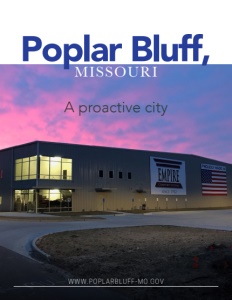Poplar Bluff, Missouri
A proactive city
Business View Magazine interviews Steve Halter of the Greater Poplar Bluff Area Chamber of Commerce, as part of our focus on best practices of American cities.
Situated in Southeast Missouri, midway between St. Louis and Memphis, Tennessee, Poplar Bluff is a small city in Butler County. The earliest permanent settlements in the area occurred in the early 19th century along the Natchitoches Trail, an old Native American Trail, west of what is now Poplar Bluff on Ten Mile Creek and Cane Creek. Butler County was organized in 1849 and Poplar Bluff was chosen as the county seat. The city took its name from a bluff that overlooks the Black River; when first settled, the bluff was covered with tulip poplar trees. In 1855, the first courthouse was built in Poplar Bluff and the town grew. It incorporated as a city on February 9, 1870.
Today, Poplar Bluff is home to about 17,000 people, and according to Steve Halter, President of the Greater Poplar Bluff Area Chamber of Commerce and head of Poplar Bluff Industries, the economic and industrial development arm of the Chamber, contracted by the city and the county to perform economic development duties, it’s a community that “does not sit back and wait for the state or the federal government to do things for us; we take a proactive stance.”
Recently, Business View Magazine spoke to Halter to find out about some of the recent and ongoing economic development projects in Poplar Bluff, which was listed by Site Selection Magazine as one of the top 100 micropolitans in the United States in 2019. The following is an edited transcript of that conversation.
BVM: What are some of the major initiatives that you and your municipal partners have accomplished recently?
Halter: “Two years ago, we took a piece of property, a rough greenfield site, and we invested funding to get the site leveled, cleared, and certified by the State of Missouri’s Department of Economic Development. We marketed that site and successfully recruited Empire Comfort Systems, a fireplace insert manufacturer. We entered into an agreement where we would build them a building and then offer a long-term lease to them with a buyout option. So, they agreed to come. We built them a 140,000-sq.-ft. facility, designed on land where they have the ability to double that capacity, which, I believe, they’ll probably do in the next few years. The building started construction in January 2019, and they opened in August 2019, which is pretty remarkable, because it was just June 2018 when we recruited them. Since then, they have acquired Primo Grills, which produces ceramic grills, and they’re bringing that production to Poplar Bluff, as well, in late 2020. So, they’re going to spend in excess of $10 million and have committed to over 100 jobs, but long-term, it will probably a lot more than that.
“In 2019, Briggs and Stratton had a decision to make on closing their facility in Murray, Kentucky or closing the one in Poplar Bluff. Whichever one they closed, all the jobs would go to the other facility. Through the retention/recruiting efforts between ourselves, the City of Poplar Bluff, the Butler County Commission, the utility companies, and the State Department of Economic Development, we were able to get that project awarded to Poplar Bluff, which will mean, in two years, about 350 jobs and over $15 million in capital expenditure. So, we’re really excited about the difference that’s going to make for Poplar Bluff. Also, New Wave Communications added a call center to their operation, recently, with an additional 75 jobs.”
BVM: What makes Poplar Bluff attractive to these and other prospective businesses?
Halter: “We’re an ACT Work Ready-certified community. We’re only the second county in the State of Missouri to be ACT Work Ready-certified. We’ve got an essential skills program called Gateway to Jobs; we work with our local high school to help those students, because we all know how important workforce skills are to economic development.”
(Work Ready Communities (WRC) is a national effort, led by ACT, to provide a framework for states, regions, and communities to build an economic-development, community-based approach grounded in certifying counties as Work Ready. ACT awards this certification when counties achieve goals, based on common criteria, of individuals in the workforce earning an ACT WorkKeys National Career Readiness Certificate and businesses recognizing or recommending the ACT WorkKeys NCRC. The ACT, originally an abbreviation of American College Testing, is a standardized test used for college admissions in the United States. It is currently administered by ACT, the nonprofit organization of the same name. The ACT test covers four academic skill areas: English, mathematics, reading, and science reasoning.)
“Also, within the last few years, we passed a school bond issue, which allowed all of our schools to be safer and to be renovated. We now have a beautiful new high school campus with new sports facilities and new STEM buildings. It just looks great. Three Rivers College has also adding many new facilities including the Libla Family Sports Complex, which was funded, mainly, from local donations.”
“The other example I would give is that we take property and get it ready, then we market it to prospects; we’re always looking for new land. In the past, we’ve also done things creatively with buildings to entice companies to come. We’re very business-friendly as far as permitting and zoning and utilities. And we’re always looking to have a diverse workforce so we’re not ingrained into one specific industry where, if something happens to that industry, it takes the whole community down.”
BVM: Any major infrastructure projects ongoing or planned for the city?
Halter: “We’re working on a four-lane project on Highway 67, south of town. When it’s finished, we’ll have four lanes in and out of Poplar Bluff – north, south, east, and west. Our ultimate goal is to have Interstate 57 come through our community; it currently stops about 45 miles from here in Sikeston. We’ve already got approval from the federal government to have that area designated as interstate, but it’s an ongoing project, and the biggest part of that project for us is this Hwy. 67 South. We took it to a vote of our people last August and it passed 88 to 12 percent; an enormous margin of victory to have the funding to get the rest of that final 12 miles four-laned all the way to the Arkansas state line. We were also awarded almost $11 million in infrastructure grants through the State of Missouri, one of which was the Governor’s Transportation Cost Share grant, to help with that project and we’re now pursuing federal dollars through a BUILD grant. That project should have the first leg started in early summer.
“I mentioned Hwy. 67 South, but before that, our citizens taxed themselves to four-lane a highway from here to St. Louis. It’s 50 miles and connects to what was already a four-lane, but before, it was just a two-lane road. Of those 50 miles, not one square inch is in the city limits of Poplar Bluff, but the city voters voted to tax themselves because they saw the importance of that infrastructure.
“We’ve had two major projects in our industrial park where we pulled funds from every organization we could find, including a local match. One was a bypass for the industrial park, which took people from our main four-lane highway straight into the park, and the other was an overpass of a Union Pacific Class 1 rail line, which prevented people from getting in and out of our industrial park in an efficient and safe manner. So, we have an overpass, now, so they don’t have to wait for those trains at a rail crossing.”
BVM: Can you talk about Poplar Bluff’s downtown and any new developments on the horizon there?
Halter: “Our only local brewery is downtown, we’ve got a coffee shop down there, and a really nice skateboard park. And we received private donations for a downtown dog park. The city is building a new city hall; we have the old historic Rogers Theatre, which just received over $300,000 in grants to rehab that facility. It mainly does plays and music and old classic films. Our major anchor in downtown is our Black River Coliseum, which is a community center that holds about 5,000 people; they do rodeos, concerts, sporting events, and conventions.
“We’ve implemented some major events that draw large crowds. We have an Iron Horse Festival every year that draws almost 10,000 people, which is pretty big for a town that’s only 17,000. We have the BBQ Street Wars, and they just recently improved the Farmers Market downtown to where they have an enclosed facility. In the past, it was just an open-air pavilion. Now, they’ve enclosed it so they can prolong the season.
“We got that downtown area designated as one of the three Opportunity Zones in our county, and we currently have an investment group looking at doing some things there. In fact, one of our major investors in the Opportunity Zone is a younger gentleman who loves this community and wants to see great things happen in the downtown. We do have some infrastructure grants from the Delta Regional Authority to do some work on the sidewalks, and we have adopted some ordinances for mixed-use so that people can live above their business. Everybody has big box stores and everyone is shopping online now. But, if we can create some sort of uniqueness to our downtown, we think people will want to go visit downtown to do some shopping, have some coffee, have a drink, listen to band play, watch a sporting event, go to the circus, or go to the rodeo.”
BVM: Are there any other Chamber of Commerce initiatives that you would want our readers to know about?
Halter: “We’re the Destination Marketing Organization for three counties: Wayne, Carter, and Butler. Our office does tourism for them, so we are promoting the outdoor activities that we have here, and we have branded our area as ‘The Gateway to the Ozarks.’ We’ve got a tourism website for those counties, and we were awarded a grant from the state’s Economic Development Authority to create short documentaries on our area to help promote tourism. We were also awarded a grant for $99,000 for a retail and industrial market analysis, and a laborshed study.
“We were also awarded a sustainability grant through USDA Rural Development for solar panels for our office. So, the Chamber of Commerce office, which sits at the busiest intersection in the community, where Hwy. 60 and Business Hwy. 67 meet, has solar panels, now. It really lets people know that we’re embracing sustainability efforts.”
AT A GLANCE
WHO: Poplar Bluff, Missouri
WHAT: A city of 17,000
WHERE: On the Black River in Butler County
WEBSITE: www.poplarbluff-mo.gov



